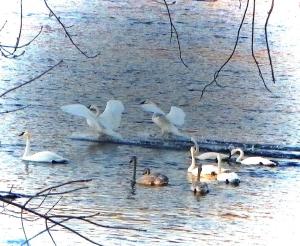| General Poetry posted December 24, 2015 | Chapters: |
...353 354 -355- 356... 
|
      |
A Rondeau Redouble
A chapter in the book Little Poems
Trumpeter Swans
by Treischel
|
These magnificent white birds are Trumpeter Swans. I wanted to celebrate their return from the brink of extinction. These ones are landing on the Mississippi River at Monticello, Minnesota, where the water is warm all year long and the river doesn't freeze over in the winter, due to the hot water released by the local Nuclear Power Plant. I made a journey there to photograph them. So that is also a part of my Muse.
The Trumpeter Swan (Cygnus buccinator) is a species of swan found in North America. The heaviest living bird native to North America, it also is on average, the largest extant species of waterfowl with a wingspan that may exceed 10 ft (3.0 m). It is the American counterpart and a close relative of the Whooper Swan (Cygnus cygnus) of Eurasia. By 1933, fewer than 70 wild Trumpeters were known to exist, and extinction seemed imminent, until aerial surveys discovered a Pacific population of several thousand Trumpeters around Alaska's Copper River. Careful reintroductions by wildlife agencies and the Trumpeter Swan Society gradually restored the North American wild population to over 46,000 birds by 2010. It is one of the heaviest living birds or animals capable of flight. The adult trumpeter swan is all white in plumage, and has a large, wedge-shaped black bill. Trumpeter Swans have similar calls to Whooper Swans and Bewick's Swans. They are loud and somewhat musical creatures, with their cry sounding similar to a trumpet, which gave the bird its name. Source: Wikipedia.
This poem is a Rondeau Redouble.
It is a poem with a very complex fixed format. It is written on two rhymes (the a and b rhymes), but in five stanzas of four lines each and one of five lines that repeats a portion of the first line of the poem. Each of the first four lines (which due to the a and b rhymes will be identified in the following stanzas as A1, B1, A2 and B2) get individually repeated in turn once in the following stanzas by becoming successively the respective fourth lines of stanzas 2, 3, 4, & 5; and the first part of the first line is repeated as a short fifth line to conclude the sixth stanza.
The stanzas each carry an abab rhyme scheme.
So with the repeat line shown in numbered capitals, this can be represented as -
A1,B1,A2,B2 - b,a,b,A1 - a,b,a,B1 - b,a,b,A2 - a,b,a,B2 - b,a,b,a,(A1).
This poem can have any meter.
The author took this photograph himself on February 16, 2012, a time when the river is usually frozen over.
Pays
one point
and 2 member cents. The Trumpeter Swan (Cygnus buccinator) is a species of swan found in North America. The heaviest living bird native to North America, it also is on average, the largest extant species of waterfowl with a wingspan that may exceed 10 ft (3.0 m). It is the American counterpart and a close relative of the Whooper Swan (Cygnus cygnus) of Eurasia. By 1933, fewer than 70 wild Trumpeters were known to exist, and extinction seemed imminent, until aerial surveys discovered a Pacific population of several thousand Trumpeters around Alaska's Copper River. Careful reintroductions by wildlife agencies and the Trumpeter Swan Society gradually restored the North American wild population to over 46,000 birds by 2010. It is one of the heaviest living birds or animals capable of flight. The adult trumpeter swan is all white in plumage, and has a large, wedge-shaped black bill. Trumpeter Swans have similar calls to Whooper Swans and Bewick's Swans. They are loud and somewhat musical creatures, with their cry sounding similar to a trumpet, which gave the bird its name. Source: Wikipedia.
This poem is a Rondeau Redouble.
It is a poem with a very complex fixed format. It is written on two rhymes (the a and b rhymes), but in five stanzas of four lines each and one of five lines that repeats a portion of the first line of the poem. Each of the first four lines (which due to the a and b rhymes will be identified in the following stanzas as A1, B1, A2 and B2) get individually repeated in turn once in the following stanzas by becoming successively the respective fourth lines of stanzas 2, 3, 4, & 5; and the first part of the first line is repeated as a short fifth line to conclude the sixth stanza.
The stanzas each carry an abab rhyme scheme.
So with the repeat line shown in numbered capitals, this can be represented as -
A1,B1,A2,B2 - b,a,b,A1 - a,b,a,B1 - b,a,b,A2 - a,b,a,B2 - b,a,b,a,(A1).
This poem can have any meter.
The author took this photograph himself on February 16, 2012, a time when the river is usually frozen over.

You need to login or register to write reviews. It's quick! We only ask four questions to new members.
© Copyright 2024. Treischel All rights reserved.
Treischel has granted FanStory.com, its affiliates and its syndicates non-exclusive rights to display this work.


